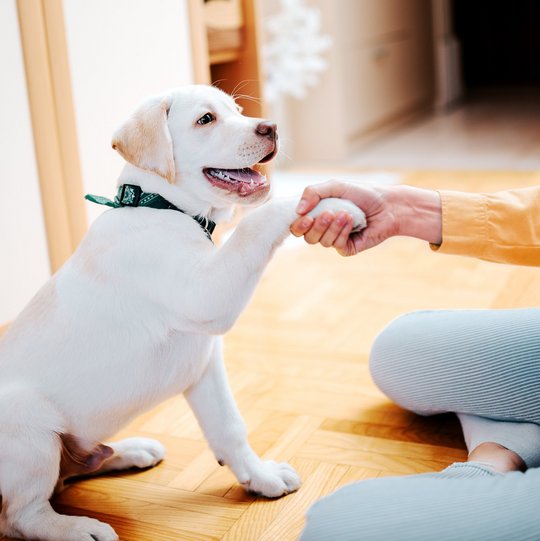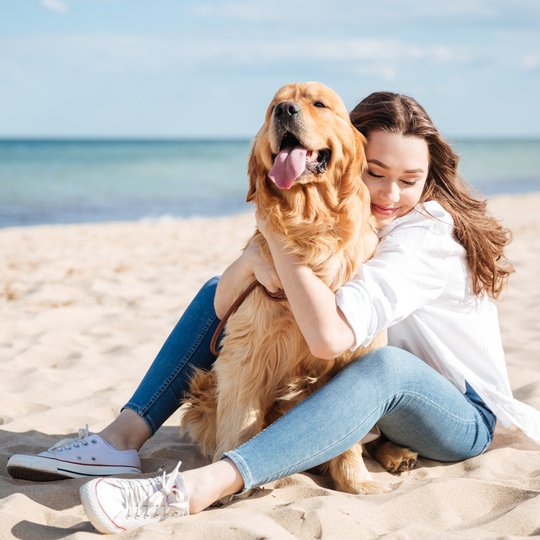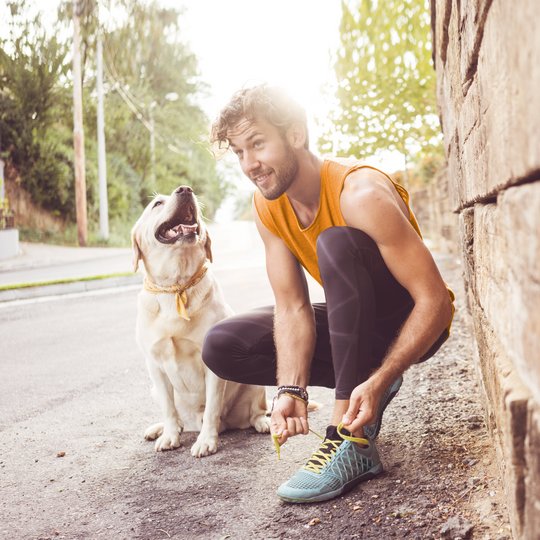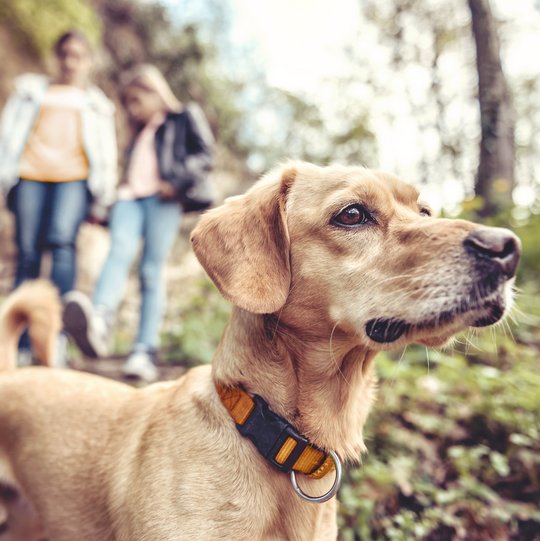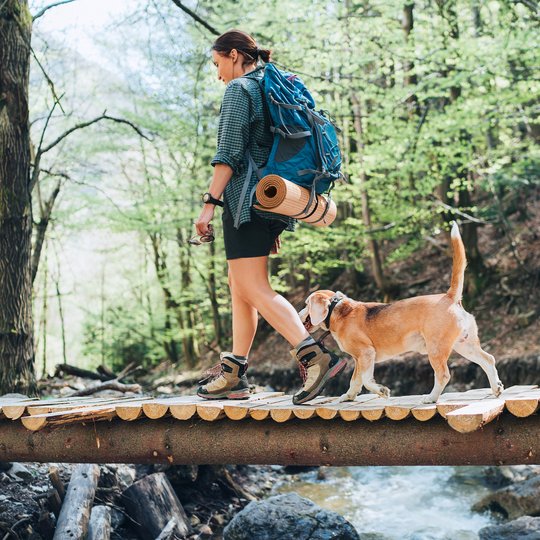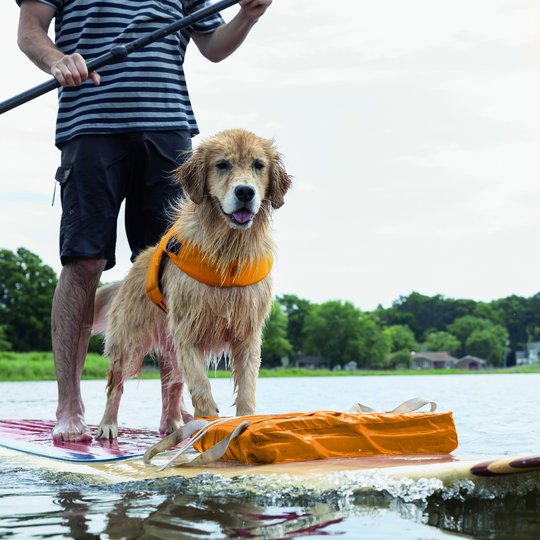Guide dog knowledge
-
What do I need to consider when raising my dog?
Those who best understand the behaviour of a dog can easily make friends with their four-legged friend.
The following basic rules should be followed when raising a dog:
- A young dog does not yet know its limits. If it tests and exceeds them, consistency is especially important.
- Your dog must learn to accept its owner as the superior in his “pack”.
- The commands should be short and memorable: “Sit”, “Come”, and “Drop”.
- A dog cannot concentrate for a long time. You should therefore take this into consideration when training and practice only in short intervals.
- Praise and reward your dog when it has done something right (e.g. with the tasty snacks from Vitakraft).
- The training should be fun for the dog. So it’s best to always end it with an exercise or game that has already been learned.
How to housebreak your puppy
After eating, sleeping, and playing, you should quickly take your puppy outside and show him where it can do its “business”. Be quick if your young dog is running around restlessly or spinning on its own axis. Lots of praise and a reward (e.g. Vitakraft Beef Stick®) will encourage it to quickly become housebroken.
Getting used to collar and lead
Even before the first walk, the young dog is accustomed to the collar and lead at home. In the beginning, it is enough if it wears the collar for a short time under supervision. Praise and reward also help here.
Train with patience and love
Dogs especially like to learn when they notice that their owner is happy about their behaviour. That’s why prompt praise and possibly a reward are indispensable when training your dog. Vitakraft has therefore developed a varied range of species-appropriate snacks in handy pack sizes. With valuable nutrients – and lots of flavour!
-
How do I feed my dog correctly?
The basics of nutrition
Species-appropriate nutrition is important to enable dogs to lead a healthy and happy life. The composition of Vitakraft products is therefore based on current scientific findings and is based on the natural needs that are already evident in wolves and wild dogs.
As descendants of the wolf, our dogs still carry much of the wolf nature within them. They are hunters and carnivores. However, it would be more correct to call them “predominantly carnivorous” – because both wolves and wild dogs also eat plant matter. In part, they ingest these directly (e.g. in the form of berries or grass). However, some plant components are also eaten via the prey (e.g. with the stomach contents).
The feed types
Main feed:
A main feed meets your dog’s basic nutritional needs.
Snacks:
Such treats are best suited for rewarding your pet and are a valuable aid in rearing and training. At the same time, a snack should also be species-appropriate and healthy. It can even fulfil an additional task (e.g. support dental care as is the case with 3in1 dental sticks). Whether hypoallergenic, cereal-free, or low-fat: The Vitakraft range also includes numerous treats for special needs.
Chewables:
Chewables are the ideal combination of occupation and dental care. In addition to the natural chews, the refined wrapped DELI CHEWS chewing bones are also highly recommended.
Food supplements:
Nutritional supplements serve to strengthen and nourish the animal. They cover special needs (e.g. during growth, after illness, for particularly active dogs, and during pregnancy).
Tips for feeding
- Feed adult dogs twice and puppies three times a day
- Feed at set times
- Serve feed at room temperature
- Do not disturb your dog during feeding
- Remove perishable food immediately
- Wash bowls thoroughly after each meal
- Continually offer fresh drinking water
- Provide tooth care snacks such as 3in1 dental sticks after the meal
-
What do I have to consider when keeping and caring for my dog?
As a dog owner, you take on a lot of responsibility. That’s because dogs are not loners but rather pack animals that depend on their humans as a surrogate pack. Some breeds have special talents or make special demands. However, many points to consider when keeping a dog apply to all breeds. These include sufficient exercise and regular health checks.
Fur care
Short-haired dogs are groomed once a week with a brush; long-haired animals, on the other hand, need intensive daily grooming. Dogs want to smell like dogs and sometimes roll around in things that we humans might find highly unpleasant. To bathe or shower off your scruffy dog, it is best to use a mild, special dog shampoo with vitamins and proteins (e.g. Bello® Shampoo from Vitakraft).
Paws and claws
If your dog rarely walks on hard surfaces, its claws can become too long. Then they need to be shortened from time to time – your vet will be happy to help. The paw pads are sensitive to snow, ice, and road salt. In winter, they must therefore be checked daily and rinsed off if necessary.
Teeth
A good tooth care support for your dog includes chewing bones from the Vitakraft range. Tooth care snack with special active ingredients such as 3in1 dental sticks are also recommended.
Ears
Once a week, you should clean your dog’s ears with a dry cloth. This is especially important for long-eared dogs.
A clean sleeping and eating place
Food and water bowls should be washed out with hot water after each meal or at least once a day. The sleeping blanket is shaken out daily and washed regularly.
-
Which dog suits me and what do I need?
Noble pure-bred dog or cheeky mongrel? Every dog has its own character. Ultimately, your personal preferences determine which dog is best for you. It is not always the affiliation to a breed that is decisive. Sometimes it is simply “love at first sight”.
Tips for buying
If you are looking for a dog, there are various options. For example, you can buy a pedigree dog from a responsible breeder. You can get addresses from the appropriate breeders’ associations. Many animal shelters have dogs waiting for a loving new home.
A healthy dog can be recognised by
-
the exuberant and lively behaviour
-
a dense coat
-
pale coloured gums (redness may indicate inflammation)
-
a wet, cold nose (but free of discharge or mucus)
-
clear eyes
-
clean ears
Check-list for the initial set-up
In order to feel really comfortable, your dog needs some accessories in addition to food:
-
A cuddly place with a sleeping basket or sleeping blanket reserved just for your dog
-
Feed bowls (e.g. made of stainless steel) and a drinking bowl
-
Toys (e.g. a ball, a play rope or rings) to keep it occupied
-
Lead, collar, or harness for walking
-
Comb and brush for grooming
-
Chewing items for occupation as well as for dental care
-
Main feed for the daily diet
-
Snacks (e.g. Vitakraft Beef Stick® or Treaties® Bits) as a reward.
-
Characteristics for a happy dog.
6 important characteristics for moments of happiness in dogs.
-
01 It wags its tail
When your dog is happy, it wags its tail vigorously. In dogs that have a short tail, the whole back end moves.
-
02 The pupils become dilated
Here, dogs are quite similar to humans: When we are happy about something, our pupils dilate. It’s the same with dogs.
-
03 Dancing gait
If your dog is happy and relaxed, its gait will be prancing and relaxed. Nothing indicates excitement or tension. Neither the tail nor the ears.
-
04 Playful behaviour
The call to play or even boisterous behaviour shows that your dog is really happy. Now it’s time to romp.
-
05 Love proximity
It’s also a clear sign of happiness if your dog specifically seeks you out and simply likes to be with you. The same is true if your four-legged friend lies quietly or asleep next to its owner. That shows great trust.
-
06 Joyful welcome
Does your dog greets you joyfully when you return home? Dogs are social animals and therefore happy when their “pack” is reunited. Share this feeling of happiness by giving your dog a big cuddle. But beware: If your dog jumps on you, this often has other reasons and should not be part of the greeting ritual.

